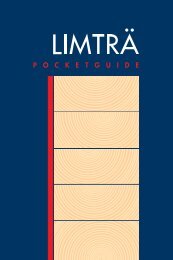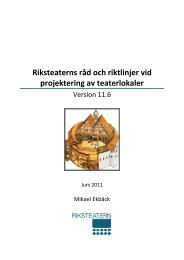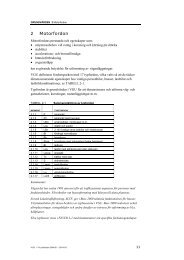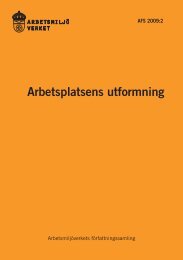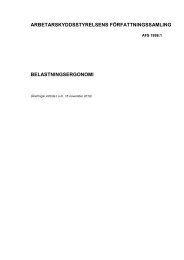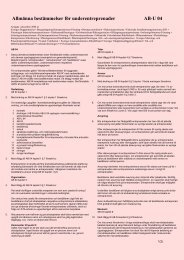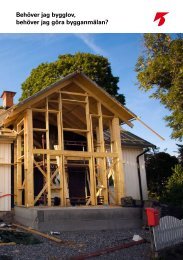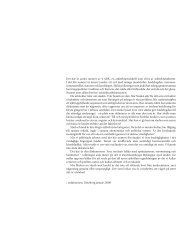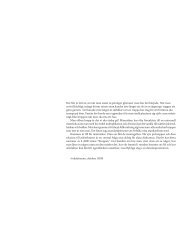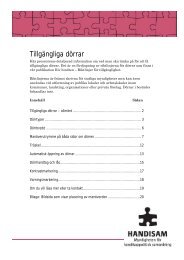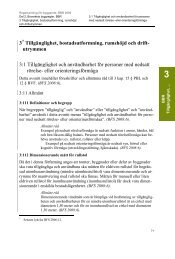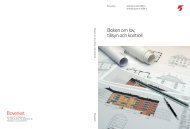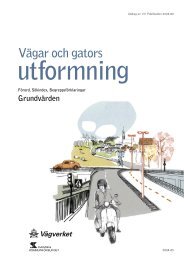CONCRETE FLESH - Archileaks
CONCRETE FLESH - Archileaks
CONCRETE FLESH - Archileaks
- No tags were found...
Create successful ePaper yourself
Turn your PDF publications into a flip-book with our unique Google optimized e-Paper software.
<strong>CONCRETE</strong> <strong>FLESH</strong><strong>CONCRETE</strong> <strong>FLESH</strong>Edited by M Lund, S Nordlander and K-G OlssonMatter Space Structure Studio Workshop November 2009Chalmers University of TechnologyDepartment of Architecture
CONTENTSThe Studio 2A Material Culture 5Concrete Flesh 7The Workshop 8Knowledge 12Plaster 17Drawing 24Concrete 32The Joy of Stuff 45Thanks To 63
The Matter Space Structure Studio is an experimental study environment formaster students from a number of educational programs within the Departmentof Architecture at Chalmers University of Technology in Gothenburg.We endorse interdisciplinary studies exploring the full advantage of thetechnical expertise of Chalmers within areas like material science fromnanoscale to large span structures, life sciences in the search for newmaterials and urban sciences from citizen participation to spatial design.We encourage studies with close ties to the local community. We regardthe city of Gothenburg as our partner along with the business communityof the region. Worldwide, we seek strategic alliances with universities andorganisations with ambitions similar to ours.We expect our fully committed students to push the limits of how to build,to design and to think architecture. Our faculty is a strong mix of young andestab l ished architects, of excellent practioners and leading scholars.2
THE STUDIO3
4A MATERIAL CULTURE
In the Matter Space Structure studio we celebrate a material culture as the coreof our commitment to architecture and teaching.The material culture is about the energy and joy of stuff. We advance theunderstanding of the matter we build from, we encourage the investigation ofthe matter we design in and we challenge the matter of the notions we think by.The material space in architecture is sensual. We perceive it through its matter.We measure its extension by the steps of our feet, we feel its limits by the touchof our fingertips, we listen to its size, we smell its materials and we see howthe sun enters a room to make it vibrate.The material structure reflects our understanding of the emerging forcesbehind a capable technological form. The pattern of the structure capturesour attention and tells about the meaning and purpose of the form. In a wellconceivedbridge we can read the pattern of forces and around a well-designedship hull we can read the force field in the water.5
6<strong>CONCRETE</strong> <strong>FLESH</strong>
Concrete is a marvellous material. In architecture the fluid stone can bemanipulated into an array of new potential shapes, to be explored by architectsand exploited by the building industry. Concrete is a tangible material with astrong sense of presence at hand. Concrete can be manipulated and comprehendedby hand. Concrete structures are corporal. Concrete is flesh.By convention concrete is often poured into square boxes. Imagine thealternative where concrete is cast in textile forms. The emerging idiom wouldlead to another architecture of soft shapes – a yielding and organic structure,accommodating and adjustable, bizarre and bony.From the Matter Space Structure Studio we asked Mark West, the artist andscholar from the University of Manitoba in Winnipeg, to come to Chalmersto share his investigations in textile cast concrete. Globally, Mark West’sexperimental research represents the leading edge of this particular disciplineof concrete architecture.7
The Matter Space Structure Studio initiated the workshop ”Concrete Flesh”, a nintense, experimental, hands-on master class based on Mark West’s research,lasting from November 17 to November 27 in 2009.An interdisciplinary group from the Chalmers faculty, consisting of PeterLindblom, Karl-Gunnar Olsson, Luping Tang and Morten Lund organized theworkshop in corporation with their colleagues Björn Engström, Steve Svenssonand Lars Wahlström and the students Vojtech Lekeš and Sanna Nordlander.The workshop took place in the hangar-sized concrete hall at Chalmers.Its generous space was originally built for testing specimens of structuralelements – a kind of real material analysis that has over the years beenmarginalized by the use of cheaper computer simulations. During ten days inNovember the large hall was filled with concrete specimens once again.The students participating in the workshop came from the Matter SpaceStructure Studio and various departments at Chalmers, and from the AarhusSchool of Architecture.8
THE WORKSHOP9
chris williamstimo schmidt10natalija subotincic
mark westnat chardpascal heinz
Mark West – artist, professor and director of CAST, Centre of ArchitecturalStructures and Technology at the Department of Architecture, University ofManitoba – lectured about his experiments with textile casts, originating froma series of architectural investigations in black and white pencil drawing. Hisunique research on textile cast concrete and his deep knowledge and vividimagination was the driving force behind the workshop.Nat Chard – architect, professor and head of the Department of Architecture,University of Manitoba – is pursuing research on the construction of drawings.For the workshop he introduced spatial investigations in drawing on large-scalepaper with charcoal and chalk as a supple ment to the conceptual models inplaster. He lectured on the bodily dimension of the construction of drawings inpanoptic exhibitions, film sets and aircraft blueprints.Natalija Subotincic – architect, associate professor and associate head of theDepartment of Architecture, University of Manitoba – has made exceptionalresearch on the mnemonics of space. She lectured on the arrangements ofartefacts in the combined clinic and home of Sigmund Freud.Chris Williams – engineer and professor at the Department of Architectureand Civil Engineering, University of Bath – has developed powerful tools andinsights in the advanced geometrics of structural design. He programmed anddesigned the refined structural form of the roof of British Museum and is nowcooperating with Mark West to qualify the textile casts into feasible structuraldesign for the building industry.12
KNOWLEDGE13
Pascal Heinz – architect and associate professor at ILEK, the Institute ofLightweight Structures and Structural Design at the University of Stuttgart –lectured on his research on hybrid forms and materials of structural elements.he has developed efficient lightweight structures that mimic the internalstructure of the bone tissue.Timo Schmidt – architect and associate professor at the Department ofMedicine, University of Tübingen and the Department of Architecture, IllinoisInstitute of Technology – presented his research about cultivated structuresthat grow and cure like living organisms which is beeing applied in the field ofmedical technology.Chris Thurlbourne – architect and associate professor from the Aarhus Schoolof Architecture – has done exceptional work in spatial manifestation and materialexpression both in his own architectural practice “Stuff” and in his studio.Anne-Mette Manelius, Kathrine Næss and Frederik Petersen – architects andresearch fellows from the Royal Danish Academy of Fine Arts and the AarhusSchool of Architecture – are all pursuing research in the field of textile castconcrete structures. They have participated in several workshops with MarkWest and all contributed to the successful outcome of this workshop.14
16PLASTER
A fluid substance which can be poured, sprayed and moulded.A three-dimensional, attractive sketching material.Easy to handle, soft, asking for touch and caress.A teacher, guiding your fingers into the stuff.Linking together idea, form, force, and shape.17
24Bodily, large scale experience.Three-dimensional action on two-dimensional surfaces.A multi-tool which translates, transforms and develops.A helping hand, a guide on the paths between concept and cast.Spontaneous, direct investigation.
DRAWING25
32Convoluted matter, demanding good planning.Self-compacting fluid in complex casts.Sensual stuff, adapting to the hand.A tough teacher, tolerating no flaws.Three-dimensional gestures of permanence.
<strong>CONCRETE</strong>33
THE JOY OF STUFF45
The world of the architect is the built reality we all live.Building is ultimately what architecture is about.Our world changes all the time, yet the architecture we use is remarkablyresilient. Concrete and stone are durable materials. In Rome and in Istanbulwe meet the ancient constructions of concrete and stone in Hadrian’sPantheon and Isidore’s Hagia Sofia, two buildings that early on spurred myinterest in architecture.The plasticity in concrete gives us a high freedom of shaping new architecture.Louis Kahn’s Salk Institute at the Pacific coast outside San Diego is a constantinspiration for my work as an architect. It was built as the research lab forJonas Salk, the inventor of the polio vaccine. The buildings frame the magnificentlandscape with their precise form. Simultaneously their supportingstructure offers maximum freedom within the laboratories.Zaha Hadid’s Phæno Science Center in Wolfsburg shows how freely we canshape modern concrete with the new, environmentally harmless plasticizersadded. The building is an extraordinary molded structure of soft forms andcrisp details.Concrete shapes our reality and gives permanence to our world.Gert Wingårdh57
62THANKS TO
The Concrete Flesh Workshop received substantial andgenerous support from the Thomas Concrete Group ABand from Betongforum – a collaboration between theSwedish Precast Concrete Federation, Cementa and theSwedish Concrete Association.63
<strong>CONCRETE</strong> <strong>FLESH</strong>Editors: Morten Lund, Sanna Nordlander, Karl-Gunnar OlssonGraphic design: Sanna NordlanderPaper: Munken Lynx 130 gPrint: Bulls Graphics AB, HalmstadCover photo: Students from the group ”F01D 5CH001” adding fibre reinforcement to concretecasted in an adjustable form made out of plastic sheets and wooden beams.Publication - Chalmers University of TechnologyDepartment of ArchitectureISSN 1650-6340, 2010:03www.chalmers.sePhotograpsRicco Andersen: p.34-35Wen Zi Ching: p.56-57Erik Hallberg: p.22-23, 59 top right,60-61Tobias Theil Konishi: p.54-55Sanna Nordlander: Cover, p.2-3, 8-9,16-17, 24-25, 30-31, 30-31, 32-33, 38-39Frederik Petersen: p.10-11, 42-43Che Wen Tseng: p.20 bottom left, p.49 bottom rightJens Zackrisson: p.48Thanks are due to all who contributed with photograps and support.Special thanks to Eva Kvarnström, OFORM.Participating students2M2C: Fan Zhiqian, Wen Zi Ching, Lan Lan, Caroline Werner, Caroline Jokiniemi, Magdalena Kmiecik,Magdalena Martyniuk. Creatures Beneath: Ricco Andersen, Alexandre Carpentier, Sizar Failli, Erik Hallberg,Maria Poll, Pether Svedberg. F01D 5CH001: Vedad Alic, Mika Friis, Ann Dahlberg, Eidhlin Ni Chathasaigh,Nikolaj Bogensee Johansen, Mikkel Horsdöl Lauridsen, Thomas Lillevang, Edouard Boisse. Flexipop: YvonneBuer, Filip Strebeyko, Ruben Stuijk, Elena Caglierotti, Adela Skrok, Tobias Pålsson, Zhang Ben Qingyuan,Oskar Strand. River: Jon Tibell, Simon Johansson, Nini Kjeldner, Salie Yo Yu, Mathias Örntoft, Hans RasmusNyvang, Vojtech Lekeš, Lars Olsson. Layer: Anna Westman, Che Wen Tseng, Hugo Franklin, Peter Sahlin, TobiasHattendorff, Torunn Melander. Monster: Lea Vakili, Lei-Ya Wong, Anders Krusegaard, Anders Lundqvist, MarcusChiu, Karl-Johan Törngren, Ola Klåvus, Mateusz Prejs. Pocket Cut: Matthias Vukovich, Tobias Theil Konishi,Trine Lykke, Sini Valvisto, Stefan Svedberg, Kamil Szczesny, Justyna Zubala, Joanna Rzysko, Liang Rui.Reinforced member: Elin Ahl, Neshat Alizadeh Ebadi, Dzejna Dedic, Fredrik Dierks, Emelie Fjeld, AnnaGlenndal, Frida Gren, Johanna Hammarfjord, Anna Hedin, Lisa Jerrhagen, Greta Jodal, Andreas Johansson,Kristin johansson, Jonas Julin, Nicklas Karlsson, My Klint, Jonas Krok, Matilda Landén, Simon Levén, AnelaMahmutovic, Dehayda Moayedza, Sepideh Moosavi Shalheh, Peter Nystedt, Gustav Reiman, Caroline Ropel, JensSandberg, Madeleine Ströby, Johan Sundberg, Gözde Derya Tumayer, Sofie Widarsson. Tarp: Kveta honzalkova,Ahmed Belkhodja, Jens Zackrisson, Anna-Karin Stråhle, Sara Thor, Vivian Gabrail, Axel Robach.64




